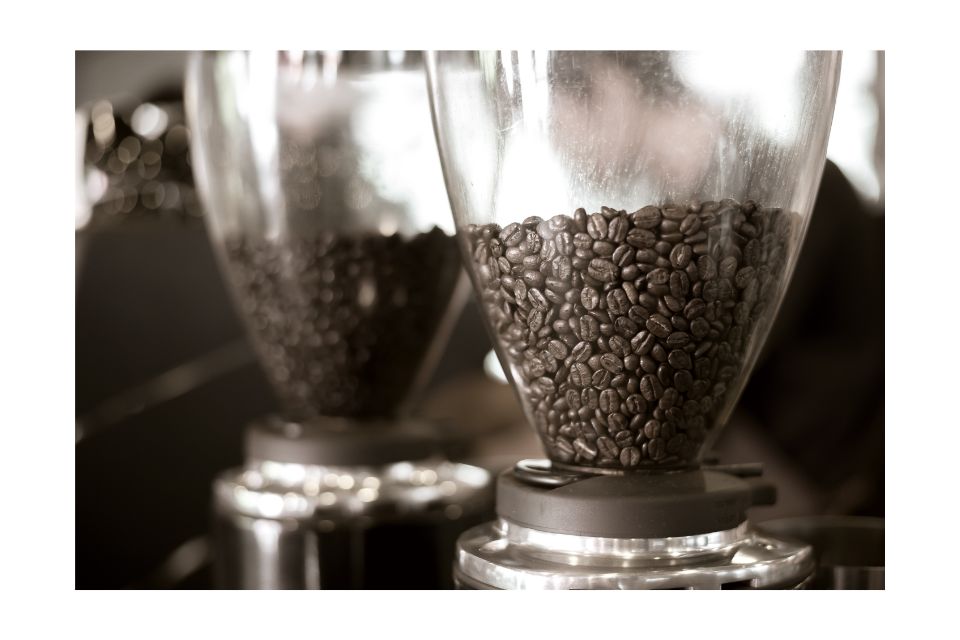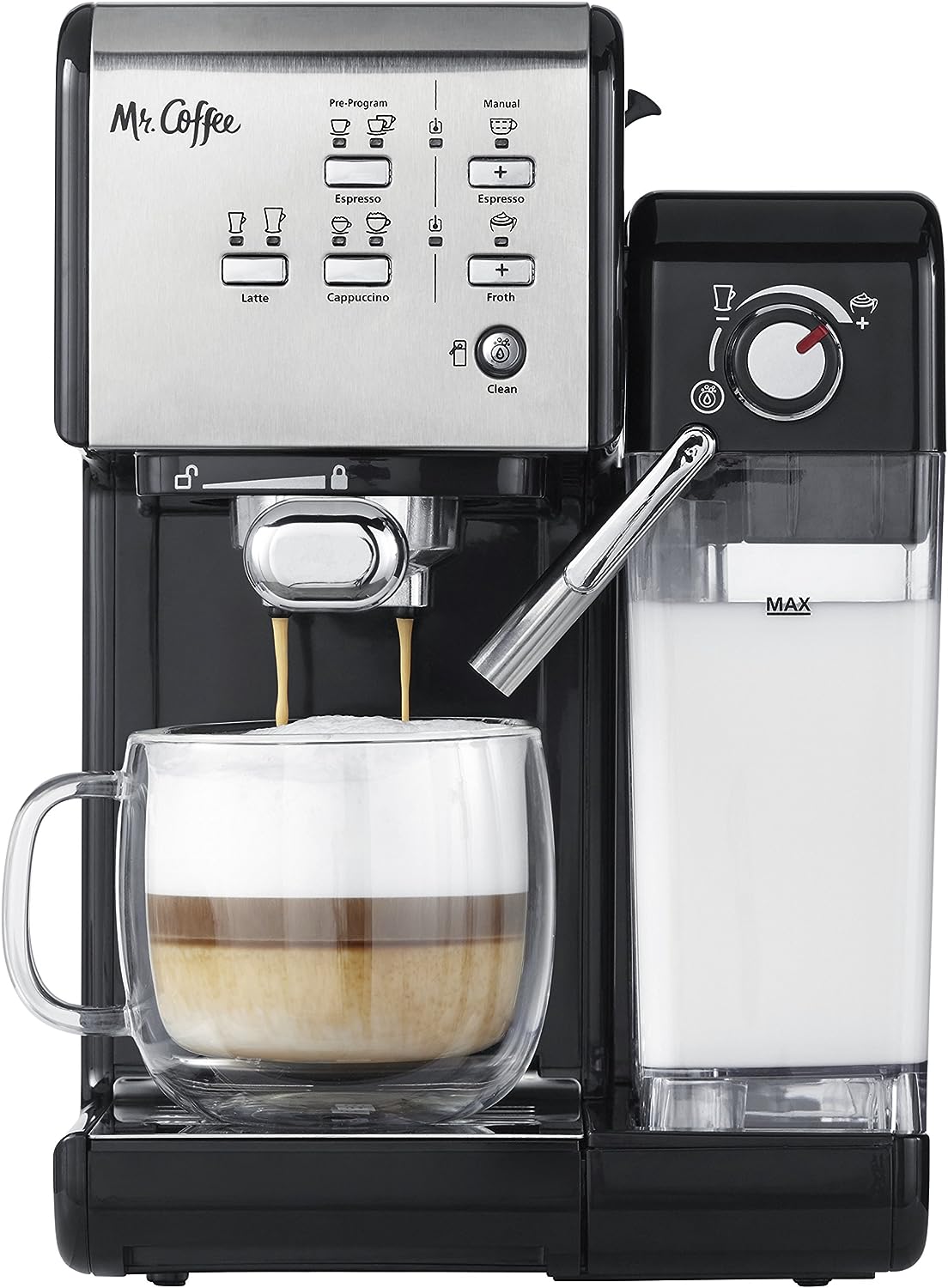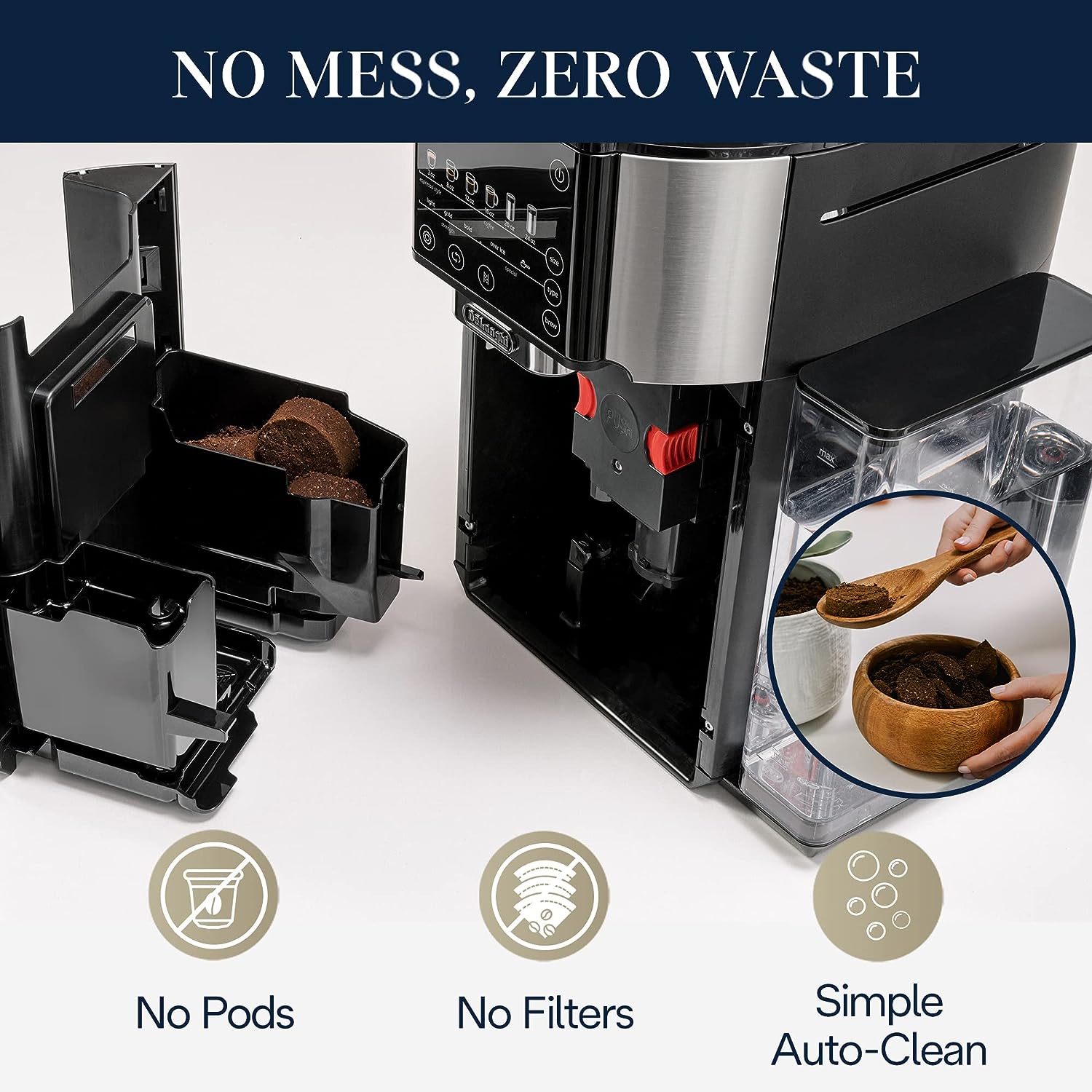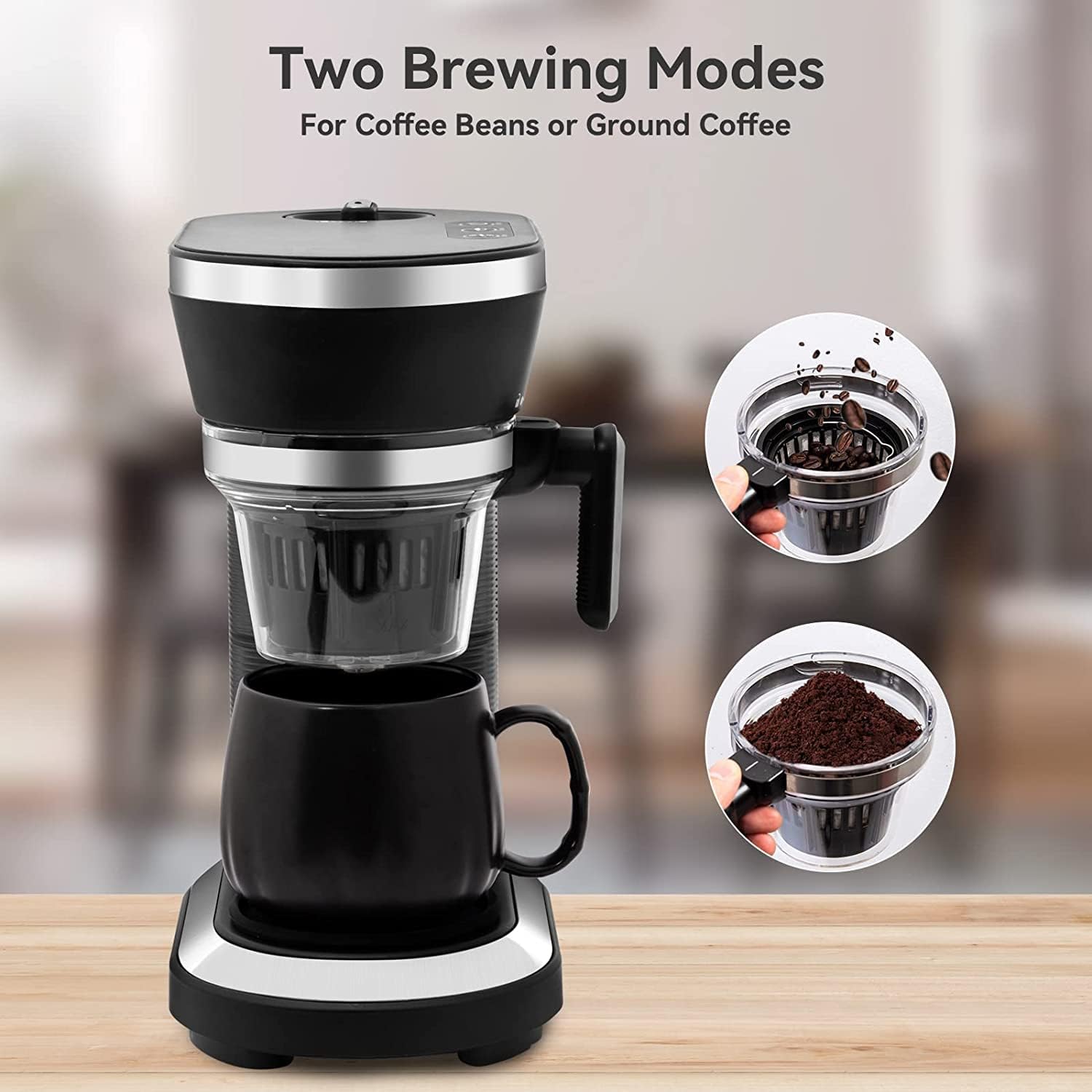Ever wondered if you can grind coffee beans in a blender at home? We’ve all been there, trying to save some money or find a quick fix in the early morning hustle. According to one coffee expert, it’s definitely possible to use your trusty blender for this task! In this article, we’ll delve into the pros and cons of grinding beans with a blender, offer tips on achieving your preferred grind size, and explore alternative methods too.
Ready to unlock new ways to savor your daily brew? Let’s jump right in!
Yes, it is possible to grind coffee beans in a blender, but there are certain factors to consider and some tips for achieving the best results.
Key Takeaways
- Grinding coffee beans in a blender is possible, but it has its pros and cons. While it’s quick and easy, blenders are not designed for grinding coffee and may result in inconsistent grind sizes.
- Factors to consider when using a blender include the power of the blender, blade sharpness, grinding time, bean quantity, bean freshness, techniques for achieving desired grind size, and consistency checks.
- Alternative methods for grinding coffee beans include using a coffee grinder (preferred method), mortar and pestle (for a traditional approach), or even a food processor (which provides more control).
- When using a blender or alternative methods to achieve the desired grind size, adjust blending time and test consistency until you find your preferred level of coarseness or fineness.
Can You Grind Coffee Beans in a Blender?
Yes, it is possible to grind coffee beans in a blender, but there are certain factors to consider and some tips for achieving the best results.
Pros and cons of using a blender
Grinding coffee beans in a blender is a contentious topic among coffee enthusiasts. While it’s certainly an option, it has its share of pros and cons, especially when compared to a dedicated coffee grinder.
| Pros | Cons |
|---|---|
| Grinding coffee in a blender is quick and easy. It’s an accessible method if you already own a blender and don’t want to invest in a dedicated coffee grinder. | Blenders are not designed to grind coffee beans, and doing so can potentially wear out the blades over time. |
| The electric-powered blades of a blender are capable of breaking up dry and tough coffee beans. | The grind size may not be consistent. You could end up with a mix of coarse and fine particles, affecting the quality of your brew. |
| By selecting the “grinder” setting or a higher speed, you can achieve a coarse grind, suitable for a French press. | Blending coffee beans can result in a coarse grind, which may not be suitable for an espresso or other brewing methods that require a fine grind. |
| Users have reported success in grinding coffee beans in blenders such as Nutribullet, Ninja, and Vitamix. | Despite some success stories, grinding coffee beans in a blender may not be as effective or efficient as using a dedicated coffee grinder. |
While the blender does offer some benefits, it’s clear that it may not be the optimal choice for grinding coffee beans, especially for serious coffee lovers who value consistency and flavor. Enjoy your brewing method and let your taste buds decide.
Factors to consider
Here are some factors to consider when grinding coffee beans in a blender:
- Blender power: Make sure your blender has enough power to grind coffee beans effectively. A higher-powered motor will be more capable of breaking down the beans into a fine grind.
- Blade sharpness: Check that the blades of your blender are sharp. Dull blades may struggle to grind the beans efficiently, resulting in an uneven grind.
- Grinding time: Blend the coffee beans in short bursts rather than continuously running the blender for an extended period. This allows for better control over the final grind size.
- Bean quantity: It is recommended to grind small batches of coffee beans at a time in a blender. Overfilling the blender can hinder proper grinding and produce inconsistent results.
- Bean freshness: Use fresh whole coffee beans for grinding in a blender. Stale or pre-ground coffee may not yield the best flavor and aroma.
- Techniques for achieving desired grind size: Experiment with different blending times to achieve your desired grind size. Shorter blending times result in coarser grinds, while longer blending times lead to finer grinds.
- Consistency check: After blending, visually inspect the ground coffee for consistency. If there are larger chunks mixed with fine particles, blend again or adjust your grinding technique accordingly.
Tips for grinding coffee beans in a blender
I’ve experimented with grinding coffee beans in a blender, and while it may not be the perfect method, it can certainly get the job done. Here are some tips to keep in mind:
- Start with small batches: It’s best to grind coffee beans in smaller quantities to ensure an even grind. This allows the blender blades to effectively break down the beans.
- Use the “grinder” setting or higher speed: Selecting the appropriate setting on your blender is crucial for achieving the desired grind size. Opt for either the “grinder” setting or use a higher speed to ensure that the coffee beans are properly pulverized.
- Securely fasten the lid: To prevent any mishaps or a messy cleanup, make sure that you securely fasten the lid of your blender before starting the grinding process.
- Blend in short bursts: Instead of continuously running the blender, pulse it in short bursts. This helps to prevent overheating and ensures a more consistent grind.
- Shake and redistribute: To achieve uniform results, stop blending after each short burst and shake or tilt your blender gently to redistribute any larger pieces that may have settled at the bottom.
Alternative Methods for Grinding Coffee Beans
Other than using a blender, there are alternative methods to grind coffee beans such as using a coffee grinder, mortar and pestle, or even a food processor.
Using a coffee grinder
When it comes to grinding coffee beans, using a coffee grinder is the most common and preferred method for coffee lovers at home. Here are some reasons why:
- Consistent grind size: A coffee grinder allows you to choose the desired grind size, whether it’s coarse, medium, or fine. This consistency is important for achieving the best flavor extraction in your cup of coffee.
- Adjustable settings: Coffee grinders usually come with adjustable settings that allow you to customize the grind size according to your brewing method. Whether you’re using a French press, pour-over, or espresso machine, a coffee grinder gives you more control over your brew.
- Retains aroma and freshness: Grinding coffee beans just before brewing helps preserve the aroma and flavor of the beans. Coffee grinders ensure that you’re only grinding what you need for each brew, keeping the rest of the beans fresh until your next cup.
- Burr vs blade grinders: Coffee grinders are available in two main types – burr grinders and blade grinders. Burr grinders are considered superior as they produce a more consistent grind size and generate less heat during grinding, which can affect the quality of the beans.
- Ease of use: Using a coffee grinder is straightforward and simple. Just measure out your desired amount of whole beans, adjust the grind size setting if needed, and let the grinder do its work.
Using a mortar and pestle
If you’re a coffee lover like me, you might be wondering if there are alternative methods for grinding coffee beans at home. One method that has been used for centuries is using a mortar and pestle. Here’s how you can grind your coffee beans using this traditional tool:
- Begin by selecting a sturdy and well – sized mortar and pestle set. The size of the set will depend on the amount of coffee beans you want to grind.
- Start by adding a small amount of coffee beans into the mortar. Remember not to overcrowd it as it could make grinding difficult.
- Hold the pestle firmly in your hand and use it to crush the beans against the bottom of the mortar in a circular motion. Apply moderate pressure while grinding to ensure an even grind.
- Continue grinding until you achieve your desired consistency. If you prefer a coarser grind, simply reduce the grinding time. For a finer grind, extend the time spent grinding.
- Once you’ve achieved your desired consistency, carefully pour out the ground coffee from the mortar into an airtight container or directly into your brewing device.
Using a food processor
I’ve discovered an alternative method for grinding coffee beans at home – using a food processor! This kitchen appliance can be a great option if you don’t have a dedicated coffee grinder. Here’s how to do it:
- Start by adding the desired amount of coffee beans into the food processor. It’s best to grind them in small batches for more consistent results.
- Securely fasten the lid of the food processor to prevent any grounds from escaping. Make sure it is locked in place before proceeding.
- Set the food processor to a medium or high speed setting. The powerful blades of the food processor are capable of breaking down the tough coffee beans into smaller particles.
- Pulse the beans in short bursts, rather than continuously running the food processor. This will help achieve a more even grind and prevent overheating.
- Keep an eye on the grind size as you pulse. Check its consistency by stopping occasionally to see if it has reached your desired fineness. If not, continue pulsing until you achieve your preferred texture.
How to Achieve the Desired Grind Size
To achieve the desired grind size, adjust the blending time and test the consistency until you find your preferred level of coarseness or fineness. Read on to learn more about grinding coffee beans in a blender and other alternative methods for a perfect brew.
Adjusting blending time
To achieve the desired grind size when using a blender to grind coffee beans, it’s important to adjust the blending time. The length of time you blend your beans will directly affect the coarseness or fineness of the grind.
If you prefer a coarser grind for methods like French press, less blending time is needed. On the other hand, if you’re aiming for a finer grind for espresso, more blending time will be necessary.
It’s essential to keep in mind that every blender is different, so it may require some trial and error to find the perfect balance for your preferred brewing method.
When adjusting blending time, start by pulsing small intervals rather than continuously running the blender. This allows you to have better control over the consistency of your coffee grounds.
After each pulse, check on the progress of your grind size and make adjustments as needed.
Remember that grinding coffee beans in a blender may not yield results as precise as those from a dedicated coffee grinder. However, with some experimentation and attention to detail when adjusting blending times, you can still achieve satisfactory results from home- ground coffee using your trusty blender.
Testing the grind size
To achieve the perfect cup of coffee, testing the grind size is crucial. After grinding your coffee beans in a blender, it’s important to assess the resulting grind size to ensure it matches your desired brewing method.
One way to test the grind size is by visually inspecting it. A coarse grind will have larger particles while a fine grind will be more powdery. You can also feel the texture of the ground coffee between your fingers – a coarser grind should feel gritty, while a finer one will be smoother.
Another effective method for testing the grind size is through experimentation with different brew times and methods. For example, if you find that your French press coffee tastes too weak or has sediment at the bottom, it may mean that you need a slightly finer grind.
On the other hand, if you’re experiencing bitter flavors or clogging issues with an espresso machine, adjusting towards a coarser grind might be necessary.
Remember that every grinder (including blenders) produces slightly different results due to variations in blade speed and cutting mechanism. So don’t be afraid to make small adjustments until you discover the ideal consistency for your preferred brewing style.
Making adjustments for different brewing methods
When it comes to grinding coffee beans in a blender, it’s important to consider the brewing method you’ll be using. Different brewing methods require different grind sizes to extract the best flavors from your coffee beans. Here are some tips for making adjustments based on your brewing preferences:
- French Press: For a French press, you’ll want a coarse grind to prevent over-extraction and a bitter taste. To achieve this, blend the coffee beans in short bursts until you reach the desired consistency.
- Drip Coffee: Drip coffee machines work best with a medium grind size. If you’re using a blender, pulse the beans for a slightly longer time than with a French press to achieve a finer grind. Aim for granules similar to sand.
- Espresso: Espresso requires a finely ground coffee to create that rich and concentrated flavor. While using a blender may not produce an espresso-worthy grind, you can still experiment by blending the beans for an extended period of time or pulsing them multiple times.
- Cold Brew: Cold brew typically requires a coarser grind compared to other methods. It’s best to use pre-ground beans or invest in a dedicated cold brew grinder instead of relying solely on a blender.
- Pour Over: A pour-over technique calls for a medium-fine grind that allows water to flow evenly through the coffee grounds. Use shorter pulses in your blender or opt for pre-ground beans specifically meant for pour-over brewing.
Conclusion
In conclusion, while it is possible to grind coffee beans in a blender, it may not always produce the ideal results. Blenders are more suitable for producing a coarse grind, which works well for methods like French press.
However, if you’re looking for finely ground coffee for espresso or other brewing methods, investing in a dedicated coffee grinder would be your best bet. Ultimately, experimenting with different grinding techniques and equipment will help you find the perfect cup of joe that suits your taste preferences.




